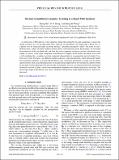Intrinsic translational symmetry breaking in a doped Mott insulator
Author(s)
Zhu, Zheng; Sheng, D. N.; Weng, Zheng-Yu
DownloadPhysRevB.98.035129.pdf (689.2Kb)
PUBLISHER_POLICY
Publisher Policy
Article is made available in accordance with the publisher's policy and may be subject to US copyright law. Please refer to the publisher's site for terms of use.
Terms of use
Metadata
Show full item recordAbstract
A central issue of Mott physics, with symmetries being fully retained in the spin background, concerns the charge excitation. In a two-leg spin ladder with a spin gap, an injected hole can exhibit either a Bloch wave or a density wave by tuning the ladder anisotropy through a “quantum critical point” (QCP). The nature of such a QCP has been a subject of recent studies by density matrix renormalization group. In this paper, we reexamine the ground state of the one doped hole, and show that a two-component structure is present in the density wave regime, in contrast to the single component in the Bloch-wave regime. In the former, the density wave itself is still contributed by a standing-wave-like component characterized by a quasiparticle spectral weight Z in a finite-size system. But there is an additional charge incoherent component emerging, which intrinsically breaks the translational symmetry associated with the density wave. The partial momentum is carried away by neutral spin excitations. Such an incoherent part does not manifest in the single-particle spectral function, directly probed by the angle-resolved photoemission spectroscopy measurement, however, it is demonstrated in the momentum distribution function. Landau's one-to-one correspondence hypothesis for a Fermi liquid breaks down here. The microscopic origin of this density wave state as an intrinsic manifestation of the doped Mott physics will be also discussed.
Date issued
2018-07Department
Massachusetts Institute of Technology. Department of PhysicsJournal
Physical Review B
Publisher
American Physical Society
Citation
Zhu, Zheng et al. "Intrinsic translational symmetry breaking in a doped Mott insulator." Physical Review B 98, 3 (July 2018): 035129 © 2018 American Physical Society
Version: Final published version
ISSN
2469-9950
2469-9969